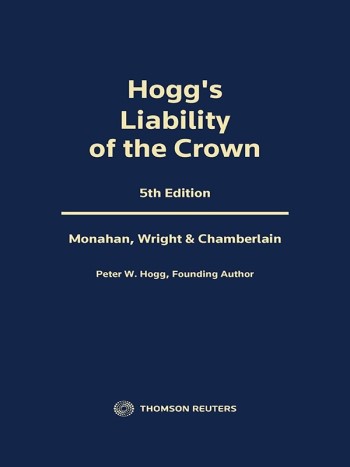
Liability of the Crown 5th Edition
|
Book $343.20* $429.00 RRP Save: $85.80 (20%) |
Date: 08/10/2024 Code: 9781038205544 Carswell, Canada |

Liability of the Crown 5th Edition
Sale Price: $343.20
Saving: $85.80 |
Available Formats
| Format | Title | Date | Code | Price | |
|---|---|---|---|---|---|
| Book | Liability of the Crown 5th Edition | 08/10/2024 | 9781038205544 | $343.20 |
Add to cart

Liability of the Crown 5th Edition
Sale Price: $343.20
Saving: $85.80 |
Description
Hogg’s Liability of the Crown, 5th Edition is a fully updated new edition of this leading text in the field of government liability – the first since the 4th Edition published in 2011.
With the government assuming an important role in most areas of economic and social life, issues relating to potential legal liability for wrongful or negligent activity have taken on increasing importance.
When things go wrong, whether it involves matters as diverse as problems with the blood supply, with unsafe drinking water, or the failure of a major financial institution, those who suffer loss inevitably look to whether their losses can be traced back to government or regulatory failure.
Highlights of New Edition
In this new 5th Edition by authors Patrick J. Monahan, Wade K. Wright and – new as of this edition – Erika Chamberlain:
- Every chapter has been carefully reviewed and comprehensively updated;
- Includes a discussion of the new Ontario Crown Liability and Proceedings Act, 2019;
- Includes a new discussion of core policy immunity, drawing on the recent decisions of the Supreme Court of Canada in R. v. Imperial Tobacco (2011) and Nelson (City) v. Marchi (2021);
- Includes a revised discussion of compensation for expropriation, drawing on the recent decision of the Supreme Court of Canada in Annapolis Group v. Halifax Regional Municipality (2022);
- Includes a revised discussion of the Crown’s sui generis fiduciary obligation to Indigenous Peoples.
Editorial Reviews
The early chapters of the book, dealing with remedies against the Crown, relate (with approval) the gradual assimilation of the Crown to private defendants and criticise the few immunities (used in a very general sense) of the Crown that persist.
Also of interest is the decision in Kingstreet Investments Ltd v New Brunswick (Finance) [2007] 1 SCR 3 dealing with the entitlement of the taxpayer to a remedy in restitution to recover money paid as tax where the tax is subsequently found to be unconstitutional.
 Government
Government